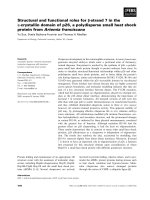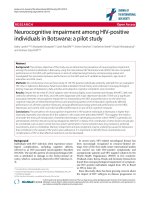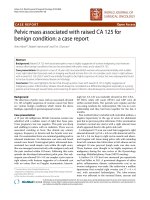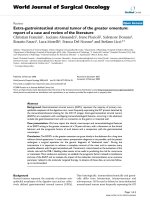báo cáo khoa học: " Risk behaviours among HIV positive injecting drug users in Myanmar: a case control study" pps
Bạn đang xem bản rút gọn của tài liệu. Xem và tải ngay bản đầy đủ của tài liệu tại đây (644.1 KB, 7 trang )
Swe et al. Harm Reduction Journal 2010, 7:12
/>Open Access
RESEARCH
© 2010 Swe et al; licensee BioMed Central Ltd. This is an Open Access article distributed under the terms of the Creative Commons At-
tribution License ( which permits unrestricted use, distribution, and reproduction in any
medium, provided the original work is properly cited.
Research
Risk behaviours among HIV positive injecting drug
users in Myanmar: a case control study
Lin A Swe*
1
, Kay K Nyo
†2
and AK Rashid
†3
Abstract
Background: The severity of HIV/AIDS pandemic linked to injecting drug use is one of the most worrying medical and
social problems throughout the world in recent years. Myanmar has one of the highest prevalence rates of HIV among
the IDUs in the region.
Aim: The objective of the study was to determine the risk behaviours among HIV positive injecting drug users in
Myanmar.
Methods: A non matched case control study was conducted among 217 respondents registered with a non
governmental organization's harm reduction center. 78 HIV positive IDUs were used as cases and 139 non HIV positive
IDUs as controls. The study was conducted between April-May 2009. Data was analysed using SPSS version 15 and the
study was ethically conducted.
Results: Factors like age, marital status, age first used drugs, drug use expenditure, reason for drug use, age first used
injection were found to be significant. Other risk factors found significantly associated with HIV among IDU were
education (OR 2.3), location of respondent (OR 2.4) type of syringe first used (OR 5.1), sharing syringe at the first
injection (OR 4.5) and failure of drug detoxification programme (OR 4.9). More HIV positive IDUs were returning used
syringes in the centre (OR 3.3).
Conclusions: Prudent measures such as access to sterile syringes and continuous health education programmes
among IDUs and their sexual partners are required to reduce high risk behaviours of IDUs in Myanmar.
Background
The severity of HIV/AIDS pandemic linked to injecting
drug use is one of the most worrying medical and social
problems throughout the world in recent years. Asia is by
no means immune to this phenomenon where HIV is
spreading early and rapidly among this group of people.
In parts of northern Myanmar and several urban areas of
Thailand, the prevalence of HIV infection up to levels of
40 to 80 percent has been recorded among injecting drug
users (IDU) [1]. Although the prevalence of HIV levels
are still very low in the Asia-Pacific region, the potential
risk of spread of HIV infection among injecting drug
users and the risk of spread of infection from them to
others is worrisome.
IDUs form one of the major risk groups for HIV trans-
mission in Myanmar. Myanmar has one of the highest
prevalence rates of HIV among the IDUs in the region
with 37.5% of the IDU population infected with HIV [2].
In Myanmar, people who are addicted to illicit drugs are
required by law to register at the government drug treat-
ment centres. Records show that 66,838 drug users were
registered as of June 2003, of which 20% were injecting
drugs. These IDU's were particularly vulnerable to HIV
[3]. The actual numbers of drug users in Myanmar are
still unknown as it is expected that most drug users do
not register. The population size of IDUs in Myanmar
generated during the estimation workshop held in Myan-
mar in 2004 ranged from 12,000-60,000. Other sources
have quoted higher ranges from 150,000 to 250,000 [4]
and 90,000 to 300,000 [4].
The objective of the study was to determine the risk
behaviours among HIV positive injecting drug users in
Myanmar.
* Correspondence:
1
Beneficial Partner Group, Myanmar. 30A 2 Inya Road. Kamayut Township,
Yangon. Myanmar
†
Contributed equally
Full list of author information is available at the end of the article
Swe et al. Harm Reduction Journal 2010, 7:12
/>Page 2 of 7
Methods
Background place of study
The study was conducted in Shan state, near the Myan-
mar and Thailand border which has a high prevalence of
IDU's in Myanmar. The centre where the programme is
run has 22 staffs including medical doctors, nurses, coun-
sellors, administrative staffs and outreach workers. The
centre helps to implement harm reduction programmes
in this part of Myanmar. This centre has collaborations
with other Non Governmental Organizations (NGO) and
local health authorities to prevent HIV transmission in
the area. Besides syringe exchange, primary health care,
referral of necessary cases, free condoms, treatment of
sexually transmitted infections (STI), abscess dressing,
hair dressing, bathing facilities, food supplies, socioeco-
nomic support and income generation supports are pro-
vided by the center. The center also provides regular
counseling and health education to IDUs. Outreach
workers from the centre regularly go to the field to
encourage drug addicts to utilize the services of the cen-
ter, provide health education, exchange needle and
syringes and search for new IDUs. Screening for HIV is
provided free of cost through the referral network with
the National AIDS Programme.
Study design
A non matched case-control study design (the controls
were not matched with the cases) was chosen to achieve
the objective of the study. The study was conducted from
January to March 2009 with the assistance of other NGOs
operating in this area such as MSI and TOP.
Sampling
The participants were recruited from among those
attending the harm reduction programme run by a non
governmental organization in Shan State. All IDUs who
were registered at this centre were eligible to participate.
Respondents who reported injecting drugs from six
months to the time of the study were designated as "cur-
rent IDUs".
HIV positive IDU's were recruited as cases and those
IDUs who were not diagnosed as HIV were recruited as
controls. Recruitment of the respondents was done with
the help of the NGO which helped select respondents
who attended the centre. The potential respondents were
informed of the study via announcements made at the
centre. The cases were defined as consenting IDU, aged
15 and above, diagnosed as HIV positive when screened
using a HIV rapid test and confirmed by the second HIV
rapid test (UNIGOLD). The controls were defined as
consenting IDU, age 15 and above, diagnosed as HIV neg-
ative by HIV rapid test and those from the same commu-
nity as the cases. The inclusion criteria included those
who consented to participate and the exclusion criteria
included those who refused to participate and were below
the age of 15 years old.
Tool s
A quantitative questionnaire was developed and field
tested prior to the actual study. The questionnaire had
questions on demography, drug use history, daily drug
expenditure, reuse and sharing of syringes, detoxification
history and awareness about HIV. Interviews were con-
ducted by volunteers who were expert in local languages.
They were trained for three days and two days of field
practice was conducted for them. The interviews were
conducted in private settings.
Laboratory Methods
The blood samples were taken from respondents after the
interview and sent to site laboratories of the National
AIDS Programme STI/AIDS Teams to perform HIV anti-
body tests. At the site laboratory, serum specimens were
screened using a HIV rapid test kit (mostly Determine)
and the reactive specimens were further confirmed by a
second HIV rapid test kit (UNIGOLD) according to
WHO testing strategy II.
Ethics
This study was ethically conducted. A verbal consent was
taken from each respondent before starting the interview
and collecting the blood sample. The confidentiality of
these patients was totally assured.
Research Analysis
Data analysis was done using SPSS version 13.0. Descrip-
tive statistics and cross tabulation were done. Chi square
test was applied and the odds ratio was calculated.
Results
All of the 217 registered injecting drug users responded
to the study, giving the response rate as 100%. Seventy
eight respondents were HIV positive and 139 were not.
As shown in table 1, there were 211 male registered IDU's
compared to 11 female registered IDUs. The age of the
participants ranged from 18 to 54 years old with the
mean age of 32.8 years. There were more HIV positive
IDUs among those within the age group of 35 years and
below (p = 0.02). Among the HIV positive IDUs there
were more married respondents followed by singles and
divorcees as compared with non HIV IDUs where most of
the respondents were single followed by married and
divorcees (p = 0.02). There is a two fold greater odds of
having HIV when the IDU is illiterate. Majority of those
with HIV positive IDUs were Shan followed by other
races and Myanmar compared to non HIV IDUs where
the majority were Myanmar followed by other races and
Shans (p = 0.02). There was no significant difference in
the religion among the HIV positive and non HIV IDUs.
Swe et al. Harm Reduction Journal 2010, 7:12
/>Page 3 of 7
There was an almost three fold greater odds of having
HIV when the IDU was from the rural area.
Patterns of drug usage among Injecting Drug Users (table
2)
For most of the responders, the first experience in using
drugs was with friends. Heroin was the most common
drug used for the first time and it was also the most com-
mon drug being used at the time of the study. The age
range the responders first started using drugs was from
13 to 44, and the mean age was 20. The most common
age for the first drug use was when they were 21 years old
and below (p = 0.05). Most of the IDUs use drugs 2-4
times per day. The expenditure incurred for drug per day
ranged from 88 to 70000 Myanmar Kyats (1000 Kyats = 1
US$) with the mean of 6591 (Kyats). Most of the IDUs
spent less than 3001 Kyats. There were more HIV positive
IDUs who spent less than 3001 Kyats but there were more
non HIV IDUs who spent more than 3000 Kyats (p =
0.05). The most common reason for drug use was peer
pressure and experimentation (p = 0.00).
Trend of injecting drug (table 3)
Injecting was the most common method of drug abuse.
More HIV positive respondents started injecting when
they were 22 years and above (p = 0.02). The common
injecting sites were forearm, arm and hand. Those using
used syringes were five fold greater risk of getting HIV as
compared to those using disposable syringes for the first
time. Those who share syringes were almost five times
more likely to developed HIV compared with those who
do not share syringes for the first time. The usage of used
syringes as well as sharing syringes had reduced at the
time the study was conducted.
Table 1: Demographics
Variable HIV N (%) Chi squared P value Odds ratio 95% CI
Yes No
Sex Male 75 (96.1%) 136 (97.8%)
Female 3 (3.9%) 3 (2.2%)
Age <=35 42 (53.9%) 96 (69.1%) 4.99 0.03
>=36 36 (46.1%) 43 (30.9%)
Marital Single 24 (30.8%) 69 (49.6%) 9.00 0.03
Married 37 (47.4%) 55 (39.6%)
Divorce 15 (19.2%) 13 (9.5%)
Widow 2 (2.6%) 2 (1.4%)
Education Illiterate 18 (23.1%) 16 (11.5%) 5.06 0.02 2.31 1.09;4.83
Literate 60 (76.9%) 123 (88.5%)
Race Myanmar 19 (24.4%) 57 (41.1%) 8.14 0.02
Shan 30 (38.4%) 32 (23.0%)
Other 29 (37.2%) 50 (35.9%)
Religion Buddhist 62 (79.5%) 110 (79.1%)
Christian 11 (14.1%) 15 (10.8%)
Muslim 5 (6.4%) 12 (8.6%)
Spiritual 0 (0%) 2 (1.4%)
Location Rural 51 (65.4%) 61 (43.9%) 9.25 0.00 2.42 1.36;4.29
Urban 27 (34.6%) 78 (56.1%)
Swe et al. Harm Reduction Journal 2010, 7:12
/>Page 4 of 7
Table 2: Patterns of Drug Usage among IDUs
Variable HIV n (%) Chi squared p value Odds ratio 95% CI
Yes No
First drug use experience Friends 62 (79.5%) 116 (83.5%)
Family 1 (1.3%) 0 (0%)
Sex worker 2 (2.6%) 0 (0%)
Other 13 (16.7%) 23 (16.5%)
First drug used # Opium 28 (31.5%) 32 (19.3%)
Heroin 46 (51.7%) 90 (54.2%)
Cough mixture 4 (4.5%) 6 (3.6%)
Diazepam 6 (6.7%) 11 (6.6%)
Marijuana 5 (5.6%) 27 (16.3%)
Present Drugs used # Opium 9 (9.8%) 9 (5.2%)
Heroin 71 (77.2%) 131 (76.2%)
Cough mixture 4 (4.4%) 2 (1.2%)
Diazepam 3 (3.3%) 15 (8.7%)
Marijuana 5 (5.4%) 15 (8.7%)
Age first used drugs <=21 45 (57.7%) 97 (69.8%) 3.23 0.05
=>22 33 (42.3%) 42 (30.2%)
Drug use frequency per day <=2 13 (16.7%) 26 (18.7%)
2-4 62 (79.5%) 106 (76.3%)
>=5 3 (3.9%) 7 (5.0%)
Drug use expenditure <=3000 38 (55.9%) 56 (40.3%) 3.55 0.05
3001-8000 20 (29.4%) 49 (35.3%)
>=8001 10 (14.8%) 34 (24.5%)
Reason for drug use Like 9 (11.5%) 24 (17.3%) 4.46 0.04
Experiment 21 (26.9%) 49 (35.3%)
Relaxation 3 (3.8%) 4 (2.9%)
Peer press 35 (44.9%) 49 (35.3%)
Upset 5 (6.4%) 11 (7.9%)
Other 5 (6.4%) 2 (1.4%)
# Multiple response
Knowledge and practice of prevention programmes (table
4)
Most of the respondents know about the Needle and
Syringe Exchange Programme and they find it easy to get
the syringes from the programme and most claim that
they would not be inclined to use more drugs if they are
given free syringes. HIV positive IDUs were three times
more likely to return used syringes. Those with history of
having unsuccessfully gone through drug treatment were
almost five times more likely to be HIV positive.
Discussion
Sharing contaminated injecting equipment is the pri-
mary mode of HIV transmission in many countries
throughout Europe and Asia and it is now a major risk
factor for the AIDS pandemic [5]. In this study we found
Swe et al. Harm Reduction Journal 2010, 7:12
/>Page 5 of 7
that those who utilized used syringes for the first time
were five times more likely be HIV positive and similarly
those who shared syringe for the first time were five times
more likely to be HIV positive. Evidence from other stud-
ies has shown the prevalence of HIV was highest among
IDUs who reported daily injection and sharing syringes
consistently [6].
This study also found that responders who were illiter-
ate and those who lived in rural areas were twice likely to
be HIV positive and most of the HIV positive responders
were of the minority race. Similar findings were found in
studies conducted elsewhere which found a higher preva-
lence of HIV among those with low education levels [7]
and among the aborigines who lived in rural areas [8].
Among the minority population in Myanmar most of
them live in rural areas which have poor access to educa-
tion system and harm reduction programmes provided
by the government and NGO's. Report from the National
AIDS programme showed a higher HIV prevalence
among ethnic minorities. This could probably be because
of the easy access to heroin in and around the permeable
borders which has resulted in an increase in the injection
mode of heroin or raw opium use especially among the
ethnic minority populations [9]. As a result of increased
use of injection mode of drug abuse there has been a
rapid increase in the rate of HIV transmission among
drug users in the border areas and northeast parts of
Myanmar.
In this study most HIV positive responders were 35
years and below and most were married. A study con-
Table 3: Trend of Injecting drugs
Variable HIV Chi squared p value Odds ratio 95% CI
Yes No
Method of Drug intake # Injection 78 (74.3%) 139 (46.6%)
Inhalation 15 (14.3%) 31 (10.4%)
Sniffing 4 (3.8%) 6 (2.0%)
Oral 8 (7.6%) 22 (7.4%)
Other 0 (0%) 100 (33.6%)
Age first IV <=21 23 (29.5%) 65 (46.8%) 6.189 0.02
=>22 55 (70.5%) 74 (53.2%)
IV location # Arm 41 (34.8%) 53 (31.55%)
Forearm 45 (38.1%) 96 (57.1%)
Finger 1 (0.9%) 1 (0.6%)
Thigh 8 (6.8%) 1 (0.6%)
Calf 5 (4.2%) 1 (0.6%)
Hand 15 (12.7%) 15 (8.9%)
Other 3 (2.5%) 1 (0.6%)
Type of syringe first use Used 44 (56.4%) 28 (20.1%) 26.64 0.00 5.13 2.79;9.44
Disposable 34 (43.6%) 111 (79.9%)
Type of syringe used now Used 5 (6.4%) 3 (2.2%)
Disposable 73 (93.6%) 136 (97.8%)
Sharing Syringe at first injection Yes 47 (60.3%) 35 (25.2%) 26.15 0.00 4.50 2.49;8.16
No 31 (39.7%) 104 (74.8%)
Sharing syringe now Yes 5 (6.4%) 7 (5.0%)
No 73 (93.6%) 132 (95%)
# Multiple response
Swe et al. Harm Reduction Journal 2010, 7:12
/>Page 6 of 7
ducted by Celentano [10] showed that those below the
age of 39 years old had more than twice the incidence of
HIV as did those aged 40 years and above [10]. Similarly,
Myanmar HIV Sero-sentinel Survey conducted in 2008
reported that majority of HIV positive IDUs in Myanmar
were 35 years and below [11]. A study by Jia [12] revealed
that married IDUs have a greater risk of getting HIV than
single or divorced IDUs.
This study also showed that HIV positive IDUs were
more likely to return used syringes and those with a his-
tory of unsuccessful drug treatment were more likely to
be HIV positive. There is substantial evidence that
syringe exchange programs are effective in preventing
HIV risk behaviour and HIV sero-conversion among
IDUs [13-15]. The reduction of the HIV incidence and
prevalence among the IDUs has successfully been
achieved by the change of the high risk behaviours as a
result of harm reduction programmes [15-17].
Limitations
There are a number of limitations in this study. The total
number of study participants was less than optimal and
the study is limited by its non matched case control
design.
Conclusions
Illiterates and the minority IDU's are at a higher risk of
being HIV positive. Health intervention programmes
should focus on these vulnerable groups with the empha-
sis on the harmful effects of sharing needles.
Competing interests
The authors declare that they have no competing interests.
Authors' contributions
LAS performed the field work and the data collection, whereas LAS and KKN
planned the write up of the article. Data was analysed by ARK.
The authors have read and approved the manuscript.
Acknowledgements
The authors would like to thank the government counterparts, staffs of the
NGO for organizing the data collection and other non-governmental organiza-
tions for their continuous efforts and support in our efforts to advance IDU
research.
Author Details
1
Beneficial Partner Group, Myanmar. 30A 2 Inya Road. Kamayut Township,
Yangon. Myanmar,
2
Department of Community Medicine, Faculty of Medicine,
AIMST University, Jalan Bedong - Semeling, 08100 Bedong, Kedah Darul Aman,
Malaysia and
3
Department of Public Health Medicine, Penang Medical College,
4 Sepoy Lines, 10450 Georgetown, Penang, Malaysia
References
1. Brown T: HIV/AIDS in Asia. Analysis from the East-West Center. Asia
Pacific Issues 2003, 68:.
2. National AIDS Programme: Report of the HIV sentinel sero-surveillance survey
Myanmar; 2008.
3. National AIDS Programme: Response to HIV/AIDS Myanmar; 2005.
4. Reid G, Costigan G: Revisiting "the hidden epidemic": a situation
assessment of drug use in Asia in the context of HIV/AIDS 2002. .
5. Institute of Medicine of The National Academics: Report on Preventing HIV
Infection among Injecting Drug Users in High Risk Countries: An Assessment of
the Evidence 2006.
6. Razak MH, Jittiwutikarn J, Suriyanon V, Vongchak T, Srirak N, Beyrer C,
Kawichai S, Tovanabutra S, Rungruengthanakit K, Sawanpanyalert P,
Celentano DD: HIV Prevalence and Risks Among Injection and
Noninjection Drug Users in Northern Thailand: Need for
Received: 29 October 2009 Accepted: 2 June 2010
Published: 2 June 2010
This article is available from: 2010 Swe et al; licensee BioMed Central Ltd. This is an Open Access article distributed under the terms of the Creative Commons Attribution License ( which permits unrestricted use, distribution, and reproduction in any medium, provided the original work is properly cited.Harm Reduction Journal 2010, 7:12
Table 4: Knowledge and practice of prevention programmes
Variable HIV Chi squared p Odds ratio 95% CI
Yes No
Knowledge of Prevention
programmes
Yes 77 (98.7%) 137 (98.56%)
No 1 (1.3%) 2 (1.4%)
Easy to get syringe Yes 76 (97.4%) 136 (97.8%)
No 2 (2.6%) 3 (2.2%)
Will use more drugs with free
syringes
Yes 7 (9.0%) 15 (10.8%)
No 71 (91.0%) 124 (89.2%)
Returning the used syringe Yes 67 (85.9%) 90 (64.8%) 11.17 0.00 3.32 1.01;6.86
No 11 (14.1%) 49 (35.3%)
Had Drug treatment Yes 73 (93.6%) 104 (74.8%) 11.19 0.00 4.91 1.84;13.14
No 5 (6.4%) 35 (25.2%)
Swe et al. Harm Reduction Journal 2010, 7:12
/>Page 7 of 7
Comprehensive HIV Prevention Programs. J of Acquir Immune Defic
Syndr 2003, 33:259-266.
7. Tran Thu Minh T, Nguyen Hien T, Yatsuya Hiroshi, Hamajima Nobuyuki,
Nishimura Akio, Ito Katsuki: HIV prevalence and factors associated with
HIV infection among male injection drug users under 30: a cross-
sectional study in Long An, Vietnam. BMC Public Health 2006, 6:248.
8. Wood E, Montaner Julio S, Li K, Zhang R, Barney LMSN, Strathdee Steffanie
A, Tyndall Mark W, Kerr T: Burden of HIV Infection Among Aboriginal
Injection Drug Users in Vancouver, British Columbia. American Journal
of Public Health 2008, 98(3):.
9. Gray J: Harm reduction in the hills of northern Thailand. Subst Use
Misuse 1998, 33:1075-1091.
10. Celentano DD, Hodge MJ, Razak MT, Beyrer C, Kawichai S, Peter Cegielski J,
Nelson KE, Jittiwutikarn J: HIV-1 Incidence among Opiate Users in
Northern Thailand. Am J Epidemiol 1999, 149:558-64.
11. National AIDS Programme: Report of the HIV sentinel sero-surveillance survey
Myanmar; 2008.
12. Jia Yujiang, Lu Fan, Zeng Gang, Sun Xinhua, Xiao Yan, Lu Lin, Liu Wei, Ni
Mingjian, Qu Shuquan, Li Chunmei, Liu Jianbo, Wu Pingsheng, SH
Vermund: Predictors of HIV infection and prevalence for syphilis
infection among injection drug users in China: Community-based
surveys along major drug trafficking routes. Harm Reduction Journal
2008, 5:29.
13. Gibson DR, Flynn NM, Perales D: Effectiveness of syringe exchange
programs in reducing HIV risk behavior and HIV seroconversion among
injecting drug users. AIDS 2001, 15(11):1329-41.
14. Bruneau J, Lamothe FC, Franco E: High Rates of HIV Infection among
Injection Drug Users Participating in Needle Exchange Programs in
Montreal: Results of a Cohort Study. Am J Epidemiol 1998, 148:713-714.
15. Effectiveness of Sterile Needle and Syringe Programming in Reducing
HIV/AIDS among Injecting Drug Users. WHO. Evidence for Action
Techinical Papers. 2004.
16. Eshrati Babak, Taghizadeh Asl Rahim, Anne Dell Colleen, Afshar Parviz,
Millson Peggy Margaret E, Kamali Mohammad, Weekes John: Preventing
HIV transmission among Iranian prisoners: Initial support for providing
education on the benefits of harm reduction Practices. Harm Reduction
Journal 2008, 5:21.
17. Wodak Alex, Cooney Annie: Effectiveness of sterile needle and syringe
programmes. International Journal of Drug Policy 2005:S31-S44.
doi: 10.1186/1477-7517-7-12
Cite this article as: Swe et al., Risk behaviours among HIV positive injecting
drug users in Myanmar: a case control study Harm Reduction Journal 2010,
7:12









